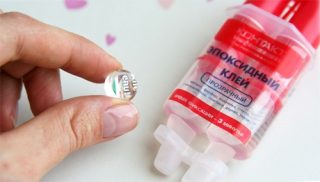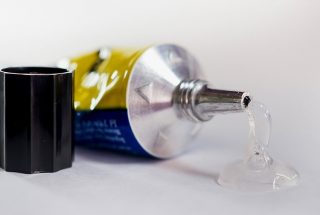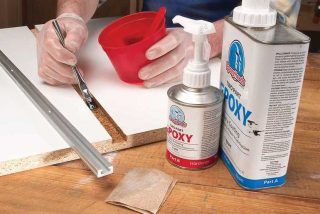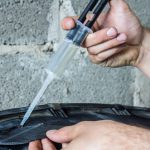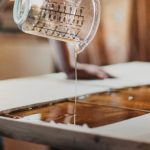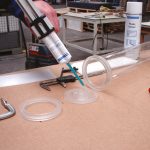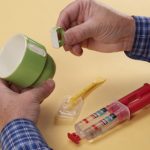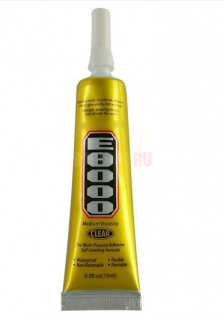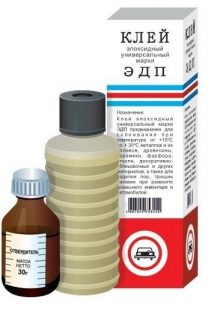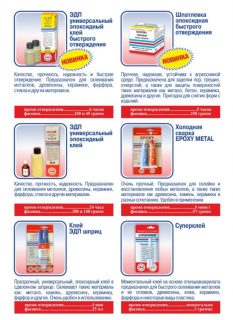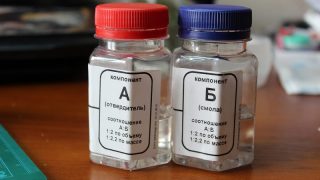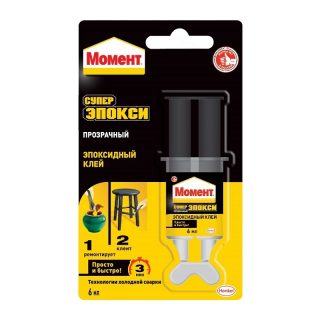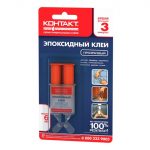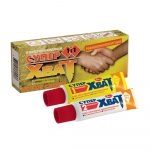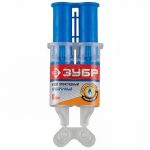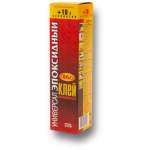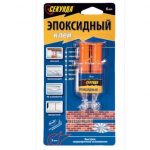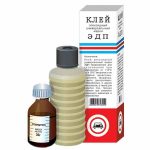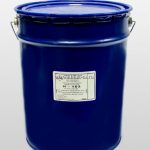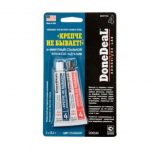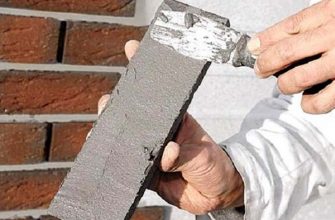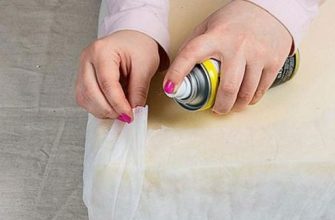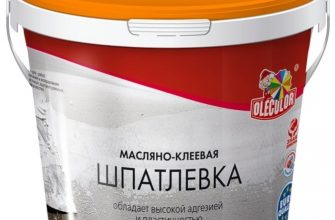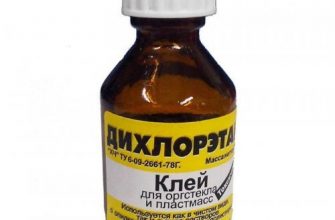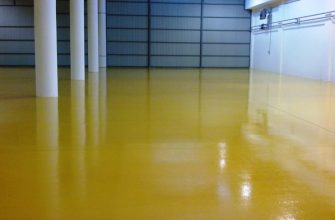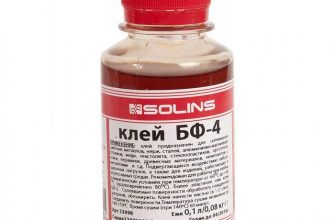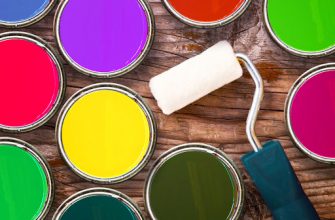Epoxy glue is made from the resin of the same name. Epoxy is not used in its pure form. To achieve the desired consistency and obtain certain characteristics, hardeners and other substances are added to the resin. Epoxy adhesive contains plasticizers in the form of acids, the ratio of which affects the viscosity and hardness of the product. The quality of the glue must meet the requirements of GOST 10587-84.
- Description and properties of the glue
- Composition and properties
- Difference from epoxy resin
- Features of use
- Formulation types and selection criteria
- Rules for the use of epoxy adhesives
- Surface treatment
- Mixing and preparing glue for work
- Parts joining technology
- Drying time
- How to store leftovers
- Precautions
- Popular manufacturers
Description and properties of the glue
Composition and properties
The composition of epoxy glue for metal, wood, concrete and other materials necessarily includes epoxy resin. In products from different manufacturers, the percentage of resin and hardeners may vary.
| Additional components in the glue | ||
| Name | Substance | Percentage of dry weight epoxy |
| Hardeners | Polymer modifiers, polyamines, aminoamides | up to 15% |
| Plasticizers | Phosphoric or phthalic acid | Up to 30% |
| Excipients | Powdered metal oxides, textiles, carbon or glass fibers, rubber, clay, chalk, formaldehyde resin | 50 to 300% |
| Solvents | Xelol, alcohols, acetone | 3 to 5% |
- the strength of the seams obtained;
- fast curing;
- density comfortable for work;
- shrinkage resistance;
- resistance to aggressive substances: oil, gasoline, water;
- resistance to temperature extremes.
Epoxy can be used to glue a variety of surfaces and materials - from huge slabs of concrete to miniature fragments of clay vases.

Difference from epoxy resin
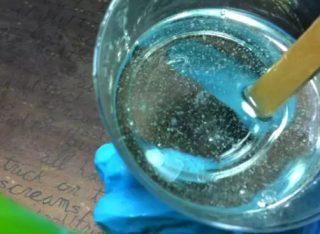
Epoxy resin has a simplified composition. Only a hardener is added to it, while glue consists of a complex combination of plasticizers and fillers... This leads to the following technical differences:
- on the polymerization resins are influenced by external physical factors - air, temperature, and the glue hardens strictly according to the instructions;
- resin used by in industry and construction, suitable for large volumes of pouring work, glue is used mainly for repairs;
- color resins are often transparent, while the glue gradually turns yellow.
The glue can be used in broader non-professional areas.
Features of use
- Building... The substance is suitable for processing plastic products, plastic pipes, for sealing joints in house panels, as well as for gluing concrete. It can act as a sealant and insulation.
- Mechanical engineering... The adhesive is used for car repairs, for sealing cracks and chips, as well as in the construction of ships and aircraft.
- Production... The substance is used for the manufacture of accessories, souvenirs and furniture.
- Electrical networks... The dielectric properties of the glue make it possible to use it for the installation of electrical networks.
- At home... Epoxy glue is used for plastic, leather, when gluing appliances, furniture and accessories.
The only area in which it is forbidden to use eapoxide is food.
Formulation types and selection criteria
Epoxy is divided into types depending on the number of components in the composition, the structure of the mixture and the method of curing. The same features determine the areas of use and the choice of the tool.
By components allocate:
- One-component composition... The adhesive can be used without the addition of solvents. Suitable for sealing joints and minor repairs, with large volumes of work, a different type of product is used.
- Two-component composition... Divided into 2 containers - hardener and composite mixture. Before use, they are connected strictly according to the instructions. This makes it possible to use it for large volumes of work.
Pasty products require mixing with water. They are similar to plasticine and are used for filling cracks or gluing large areas. They also close up the electrical insulation of mechanisms.
Also distinguish types of glue by curing method:
- Fast setting and full hardening for 1-3 days at an average temperature of 20 degrees Celsius... The mixtures are made from liquefied resin, aliphatic polyamide and plasticizers. Compositions require heat treatment to increase resistance to aggressive environments.
- Solidifying at + 60-120 degrees mixtures. These compounds are intended for heat treatment and are used where oils and gasoline constantly act on the seams.
- Ultra-strong mixtures that set at temperatures from +140 degrees. They are used in heat-resistant installations and power grids.
The last two types of mixtures are more often used for professional rather than domestic purposes.
Rules for the use of epoxy adhesives
For the full disclosure of the advantages of one-component or two-component adhesive, it is important to strictly follow the instructions for its use.
Surface treatment
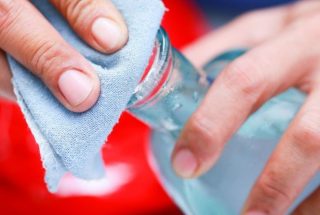
To achieve high adhesion of materials, the surface of the glued objects must be carefully processed:
- Cleaning... Remove dust, dirt and rust mechanically or chemically.
- Grinding... Level the surface, remove traces of glue or paint. Grinding is used for processing glass, wood, concrete, metal. To do this, use sandpaper with a grain size of 40 to 80.
- Degreasing... With the help of acetone or alcohol, invisible traces of fat are removed.
Immediately after preparing the surfaces, you can start working with the glue.
Mixing and preparing glue for work
Each manufacturer supplies products with detailed instructions. Mixing times and mixing patterns can vary greatly.

The finished substance is immediately applied to the cleaned surfaces in a very thin layer.
- parts of two-component glue are mixed gradually and gently;
- knead with a wooden spatula or stick;
- if the composition is too thick, you can heat it up to 55-60 degrees;
- you can also use weak solvents: alcohol, xylene, acetone, nail polish remover.
Once the mixture is ready, start gluing.
Parts joining technology
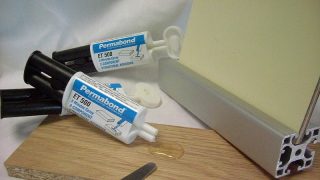
Work surfaces must be perfectly dryas water impairs adhesion. Indoor temperature - within 22-26 degreesotherwise the glue will not work properly.
Before application, the materials to be glued can be warmed up to 38-40 degrees, if their properties allow it. Use a hair dryer, fan or IR lamp for heating.
After applying the glue, the parts are pressed tightly against each other for a few seconds. Then they are left to dry.
Drying time
The parameter depends on the manufacturer. Some formulations will completely cure in 5-20 minutes. Others need 2-3 hours. Still others harden in 2-3 days. The time is indicated in the instructions.

How to store leftovers
In most cases, epoxy glue is stored in its original packaging at a temperature of 20 to 25 degrees. The packaging should not be exposed to sunlight, moisture, too hot or cold air. Keep the composition away from food.
Precautions
When using epoxy adhesive, it is recommended to use a protective mask with a charcoal filter. All work is carried out in a well-ventilated area. If a person has sensitive skin, rubber gloves are used when working.
Do not mix the compounds in the dishes from which they are eaten. To do this, use a container, which is then thrown away.
Popular manufacturers
- "Moment";
- "Contact";
- "Super-grip";
- "Class" and "Bison";
- "Novokolor epoxy universal glue";
- "Second";
- "EDP";
- "Compound K-153";
- DoneDeal "Epoxy Adhesive" in the form of a syringe.

